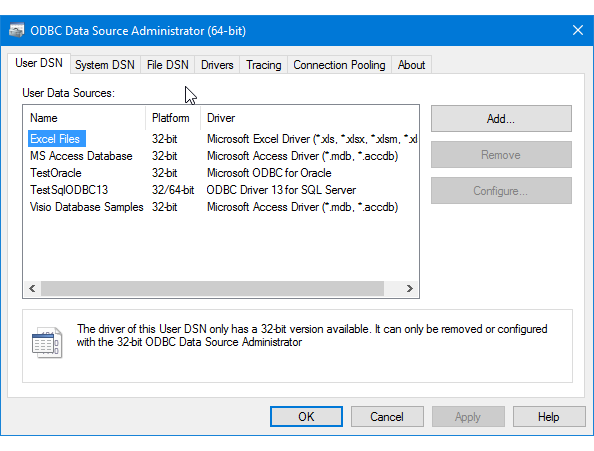
Microsoft Sql Server 2008 Odbc Driver For Mac
Install the Microsoft ODBC driver for SQL Server (Linux). 11 minutes to read.In this articleThis article explains how to install the Microsoft ODBC Driver for SQL Server on Linux.
It also includes instructions for the optional command-line tools for SQL Server ( bcp and sqlcmd) and the unixODBC development headers.This article provides commands for installing the ODBC driver from the bash shell. If you want to download the packages directly, see.
ODBC connector to SQL Server high-performance and feature-rich connectivity solution for ODBC-based applications to access SQL Server databases from Windows, Linux, both 32-bit and 64-bit. The Exchange ODBC Driver is a powerful tool that allows you to easily connect-to live Microsoft Exchange data through any ODBC capable application or tool!
Microsoft ODBC 17The following sections explain how to install the Microsoft ODBC driver 17 from the bash shell for different Linux distributions. Realtek usb drivers. ImportantIf you installed the v17 msodbcsql package that was briefly available, you should remove it before installing the msodbcsql17 package. This will avoid conflicts. The msodbcsql17 package can be installed side by side with the msodbcsql v13 package.
Alpine Linux #Download the desired package(s)curl -O -O Verify signature, if 'gpg' is missing install it using 'apk add gnupg':curl -O -O gpg -import -gpg -verify msodbcsql1717.5.2.2-1amd64.sig msodbcsql1717.5.2.2-1amd64.apkgpg -verify mssql-tools17.5.2.1-1amd64.sig mssql-tools17.5.2.1-1amd64.apk#Install the package(s)sudo apk add -allow-untrusted msodbcsql1717.5.2.2-1amd64.apksudo apk add -allow-untrusted mssql-tools17.5.2.1-1amd64.apk. NoteDriver version 17.5 or higher is required for Alpine support. NoteYou can substitute setting the environment variable 'ACCEPTEULA' with setting the debconf variable 'msodbcsql/ACCEPTEULA' instead: echo msodbcsql17 msodbcsql/ACCEPTEULA boolean true sudo debconf-set-selections Previous versionsThe following sections provide instructions for installing previous versions of the Microsoft ODBC driver on Linux. The following driver versions are covered:.ODBC 13.1The following sections explain how to install the Microsoft ODBC driver 13.1 from the bash shell for different Linux distributions. ImportantThese instructions refer to msodbcsql-11.0.2270.0.tar.gz, which is installation file for Red Hat Linux.
If you are installing the Preview for SUSE Linux, the file name is msodbcsql-11.0.2260.0.tar.gz.To install the driver:.Make sure that you have root permission.Change to the directory where the download placed the file msodbcsql-11.0.2270.0.tar.gz. Make sure that you have the.tar.gz file that matches your version of Linux. To extract the files, execute the following command, tar xvzf msodbcsql-11.0.2270.0.tar.gz.Change to the msodbcsql-11.0.2270.0 directory and there you should see a file called install.sh.To see a list of the available installation options, execute the following command:./install.sh.Make a backup of odbcinst.ini. The driver installation updates odbcinst.ini. Odbcinst.ini contains the list of drivers that are registered with the unixODBC Driver Manager.
To discover the location of odbcinst.ini on your computer, execute the following command: odbcconfig -odbcinstini.Before you install the driver, execute the following command:./install.sh verify. The output of./install.sh verify reports if your computer has the required software to support the ODBC driver on Linux.When you are ready to install the ODBC driver on Linux, execute the command:./install.sh install. If you need to specify an install command ( bin-dir or lib-dir), specify the command after the install option.After reviewing the license agreement, type YES to continue with the installation.Installation puts the driver in /opt/microsoft/msodbcsql/11.0.2270.0. The driver and its support files must be in /opt/microsoft/msodbcsql/11.0.2270.0.To verify that the Microsoft ODBC driver on Linux was registered successfully, execute the following command: odbcinst -q -d -n 'ODBC Driver 11 for SQL Server'. UninstallYou can uninstall the ODBC driver 11 on Linux by executing the following commands:.rm -f /usr/bin/sqlcmd.rm -f /usr/bin/bcp.rm -rf /opt/microsoft/msodbcsql.odbcinst -u -d -n 'ODBC Driver 11 for SQL Server'Driver filesThe ODBC driver on Linux consists of the following components: ComponentDescriptionlibmsodbcsql-17.X.so.X.X or libmsodbcsql-13.X.so.X.XThe shared object ( so) dynamic library file that contains all of the driver's functionality. This file is installed in /opt/microsoft/msodbcsql17/lib64/ for the Driver 17 and in /opt/microsoft/msodbcsql/lib64/ for Driver 13.msodbcsqlr17.rll or msodbcsqlr13.rllThe accompanying resource file for the driver library. This file is installed in driver.so directory./share/resources/enUS/msodbcsql.hThe header file that contains all of the new definitions needed to use the driver.Note: You cannot reference msodbcsql.h and odbcss.h in the same program.msodbcsql.h is installed in /opt/microsoft/msodbcsql17/include/ for Driver 17 and in /opt/microsoft/msodbcsql/include/ for Driver 13.LICENSE.txtThe text file that contains the terms of the End-User License Agreement.

This file is placed in /usr/share/doc/msodbcsql17/ for Driver 17 and in /usr/share/doc/msodbcsql/ for Driver 13.RELEASENOTESThe text file that contains release notes. This file is placed in /usr/share/doc/msodbcsql17/ for Driver 17 and in /usr/share/doc/msodbcsql/ for Driver 13.Resource file loadingThe driver needs to load the resource file in order to function. This file is called msodbcsqlr17.rll or msodbcsqlr13.rll depending on the driver version. The location of the.rll file is relative to the location of the driver itself ( so or dylib), as noted in the table above. As of version 17.1 the driver will also attempt to load the.rll from the default directory if loading from the relative path fails.
The default resource file path on Linux is /opt/microsoft/msodbcsql17/share/resources/enUS/. TroubleshootingIf you are unable to make a connection to SQL Server using the ODBC driver, see the known issues article on.
Next stepsAfter installing the driver, you can try the. For more information about developing ODBC applications, see.For more information, see the ODBC driver. Related Articles.